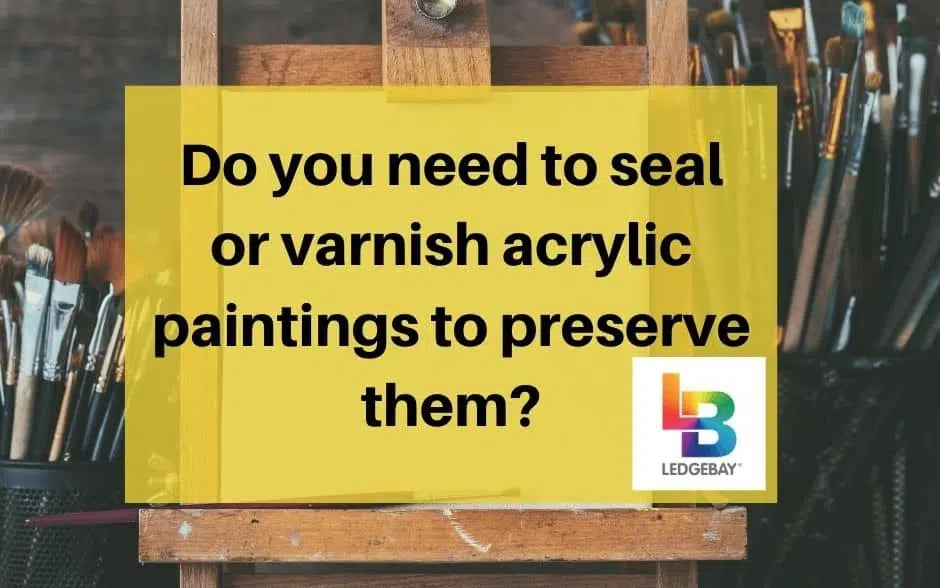Have you recently painted a new masterpiece? Are you wondering whether you need to sealacrylic paintings or varnish to preserve them? Well, this article will give you the ultimate answer!
As apainting medium , acrylics behave differently from their counterparts: oilpaints and watercolors . Consequently, you can’t treat them the same. This is why you should take good care while preserving them to have the best outcomes. The answer to this question mainly depends on the purpose of thepainting . Lots of artists want to preserve their work for the longest time to let their portfolio or gallery speak of their artistic talent.
The answer to this question mainly depends on the purpose of thepainting . Lots of artists want to preserve their work for the longest time to let their portfolio or gallery speak of their artistic talent.
[amazon box="B08J1JKPSZ"]
Otherpainters preserve their paintings for business purposes. Selling a high-qualitypainting that can last for decades or even centuries is the best thing that can happen to your career.
Arguably, someartists prefer to keep the painting without a varnish layer. Those who prefer this might go for a later round of fixing mistakes or even repainting thewhole canvas . Beginners may also skip the varnishing process since it can be quite demanding and time-consuming.
Lights, especiallyultraviolet rays , may cause significant damage to your painting as they make the colors gradually fade away. Varnish pays off because it contains certain chemicals that reflect the UV lights.
[amazon box="B000HF4GR6"]
Dust or dirt can be a major problem that you want to avoid as well. They settle on the paintings, and the canvas material can easily absorb them over time.
Choosing from gloss, satin, or mattevarnish sheen options , you can create a smoother look that keeps the painting forever new.
Bear in mind that removing a varnish coat, even if it’s a removable varnish, takes lots of time. So, if you need more time tofix your acrylic painting or you think this isn’t the best you can give, a varnishing coat won’t be ideal.
Also, you may not have enough knowledge about the best types of varnish and how it works. If so, check the upcoming sections. Varnish comes in two forms:brush-on and spray-on . It’s preferable to use brush-on varnish if you want control over the coat’s direction and thickness. On the contrary, a spray-on gives an even sheen. Plus, it is ideal for large surfaces.
Varnish comes in two forms:brush-on and spray-on . It’s preferable to use brush-on varnish if you want control over the coat’s direction and thickness. On the contrary, a spray-on gives an even sheen. Plus, it is ideal for large surfaces.
[amazon box="B001YJTUPW"]
Let’s see how to protectacrylic painting on canvas .
[amazon box="B086JD7TKZ"]
[amazon box="B07S2R6SVL"]
Dip the tip of the brush in the dish andvarnish in the same direction you painted . This will enhance light reflection and accentuate the texture. If you just stroke the piece up and down or back and forth, you could get a weird, inconsistent look.
Gently and slowlycover the painting with the varnish . Don’t overdo the varnish, or else you might desaturate the colors. If you accidentally put excess varnish in a spot, you can go back and remove it. Always wash your brush or dedicate a brush for varnishing only.
You may choose to add another coat of varnish to give the piece a more vibrant look. However, make sure to let each varnish coat completely dry at first. There’re lots of varnishes that you can use to sealacrylic paintings . They’re divided according to their base intowater-based and solvent-based varnishes .
There’re lots of varnishes that you can use to sealacrylic paintings . They’re divided according to their base intowater-based and solvent-based varnishes .
However, some people find its application a bit challenging because it’s basically white. This might feel confusing since you can’t know how the coat will look when its color fades. Liquitex makes a non-toxic water-based varnish, so you don’t have to wear a mask.
[amazon box="B000KNJE36"]
Solvent-based varnishes are super simple to apply. But you must wear a respirator to avoid breathing any toxic chemicals. A Liquitex solvent-based varnish would also be helpful if you’re restoring an old painting because of how delicate and intricate it is.
For this type of varnish, you’ll have to let the painting dry for at least three to four days toget the best results . You’ll also need to clean it up from brushes by using white spirit, also known as mineral turpentine.
If you want an odorless, quick-to-dry varnish, try a water-based varnish. If you’re searching for an easy-to-apply but a quite pungent product, use a solvent-based one.
And don’t forget to enjoy the process to the fullest!
Don't forget to check out the latest Ledgebay Paint by Numbers -->CLICK HERE
As apainting medium , acrylics behave differently from their counterparts: oilpaints and watercolors . Consequently, you can’t treat them the same. This is why you should take good care while preserving them to have the best outcomes.
Should You Varnish an Acrylic Painting?
 The answer to this question mainly depends on the purpose of thepainting . Lots of artists want to preserve their work for the longest time to let their portfolio or gallery speak of their artistic talent.
The answer to this question mainly depends on the purpose of thepainting . Lots of artists want to preserve their work for the longest time to let their portfolio or gallery speak of their artistic talent.[amazon box="B08J1JKPSZ"]
Otherpainters preserve their paintings for business purposes. Selling a high-qualitypainting that can last for decades or even centuries is the best thing that can happen to your career.
Arguably, someartists prefer to keep the painting without a varnish layer. Those who prefer this might go for a later round of fixing mistakes or even repainting thewhole canvas . Beginners may also skip the varnishing process since it can be quite demanding and time-consuming.
Why Varnish?
There are manyreasons to consider varnishing youracrylic paintings . Here are some of the most important ones.1. Protect From Atmospheric Conditions
Weather, light, and dust will harm youracrylic paintings . Constantly shifting temperature and humidity are paintings’ worst enemies. If the temperature gets too hot or too cold, this can cause the paint to flake and become unstable.Lights, especiallyultraviolet rays , may cause significant damage to your painting as they make the colors gradually fade away. Varnish pays off because it contains certain chemicals that reflect the UV lights.
[amazon box="B000HF4GR6"]
Dust or dirt can be a major problem that you want to avoid as well. They settle on the paintings, and the canvas material can easily absorb them over time.
2. Unify the Quality
Sealingacrylic painting by using a removable or non-removable varnish gives a more homogenous look to the painting. While differences in sheen can occur, a varnish layer helps unifying it all out.Choosing from gloss, satin, or mattevarnish sheen options , you can create a smoother look that keeps the painting forever new.
3. Gives the Vibes of a Brand-New Looking Painting
Acrylic paints have different properties; some are more pigmented or shinier than others. Varnish enhances the overall quality as it sharpens and deepens the colors. This results in a more coherent appearance.Why Not Varnish?
Here are the cases where varnishing won’t be ideal.1. You’re Not Done With the Painting Yet
Despite the convenient benefits of a varnish coat, some painters don’t necessarily do it, especially if they’re only using the canvas to practice.Bear in mind that removing a varnish coat, even if it’s a removable varnish, takes lots of time. So, if you need more time tofix your acrylic painting or you think this isn’t the best you can give, a varnishing coat won’t be ideal.
2. You’re a Beginner
The varnishing process is quite hectic and time-consuming, especially if you’re a beginner. You’ll have to try more than one time to make it perfect. This may not be possible for everyone.Also, you may not have enough knowledge about the best types of varnish and how it works. If so, check the upcoming sections.
When Should You Varnish an Acrylic Painting?
Well, it usually differs from a product to another. Generally, youneed to wait for the painting to dry completely, or else smudges might form. To make sure, slightly press your fingernail into the thickest paint area; if it's firm, you can carry out the procedure.How to Varnish an Acrylic Painting?
 Varnish comes in two forms:brush-on and spray-on . It’s preferable to use brush-on varnish if you want control over the coat’s direction and thickness. On the contrary, a spray-on gives an even sheen. Plus, it is ideal for large surfaces.
Varnish comes in two forms:brush-on and spray-on . It’s preferable to use brush-on varnish if you want control over the coat’s direction and thickness. On the contrary, a spray-on gives an even sheen. Plus, it is ideal for large surfaces.[amazon box="B001YJTUPW"]
Let’s see how to protectacrylic painting on canvas .
Step 1: Prepare Your Workplace
Make sure yourpainting surface is dust-free and that the temperature is above 50 °F. Always dry-clean thepainting before varnishing to get rid of dirt or dust.Use a soft, wide brush or a plain cloth for this. Put on gloves and a protective mask to protect your respiratory system.[amazon box="B086JD7TKZ"]
Step 2: Prepare Your Painting
Make sure your painting is absolutely dry; this can take a couple of weeks if you applied athick coat of paint . Lay your canvas flat on a desk so that the varnish doesn’t drip or becomes chunky. Avoid touching the varnish until it completely dries.Step 3: Apply Varnish
To start off, pick a 2-inch flat brush or another one that is similar in size to the brushesyou painted with. Pour some varnish in a small cup or a shallow dish.[amazon box="B07S2R6SVL"]
Dip the tip of the brush in the dish andvarnish in the same direction you painted . This will enhance light reflection and accentuate the texture. If you just stroke the piece up and down or back and forth, you could get a weird, inconsistent look.
Gently and slowlycover the painting with the varnish . Don’t overdo the varnish, or else you might desaturate the colors. If you accidentally put excess varnish in a spot, you can go back and remove it. Always wash your brush or dedicate a brush for varnishing only.
Step 4: Modify Varnish to Your Taste
You’ll learn how to varnish anacrylic painting by the process of trial and error. So don’t get overwhelmed by how long the process takes because it’s worth your while.You may choose to add another coat of varnish to give the piece a more vibrant look. However, make sure to let each varnish coat completely dry at first.
What Is the Best Varnishing Product?
 There’re lots of varnishes that you can use to sealacrylic paintings . They’re divided according to their base intowater-based and solvent-based varnishes .
There’re lots of varnishes that you can use to sealacrylic paintings . They’re divided according to their base intowater-based and solvent-based varnishes .Water-Based Varnish
You can apply a coat of a water-based varnish in two hours after theacrylic painting is done. You can easily clean wet water-based varnish from the brushes andpaintings with nothing but water and soap.However, some people find its application a bit challenging because it’s basically white. This might feel confusing since you can’t know how the coat will look when its color fades. Liquitex makes a non-toxic water-based varnish, so you don’t have to wear a mask.
[amazon box="B000KNJE36"]
Pros
Cons
- Might be tricky to apply because it’s milk-colored rather than clear
Solvent-based varnishes are super simple to apply. But you must wear a respirator to avoid breathing any toxic chemicals. A Liquitex solvent-based varnish would also be helpful if you’re restoring an old painting because of how delicate and intricate it is.
For this type of varnish, you’ll have to let the painting dry for at least three to four days toget the best results . You’ll also need to clean it up from brushes by using white spirit, also known as mineral turpentine.
Pros
- Easy to use
- Clear colored, so you’ll be able to see underneath
- Ideal for use in restoration
Cons
- Strong odor
- You’ll need mineral turpentine to clean it
The Conclusion - Do you need to seal acrylic paintings
Do youneed to seal acrylic paintings ? This is left for your discretion. Topreserve acrylic paintings for a long time and keep them protected against UV lights, yellowing, and dust, apply one or more coats of varnish. If you still have some final touches to do, you don’t need a sealing varnish.If you want an odorless, quick-to-dry varnish, try a water-based varnish. If you’re searching for an easy-to-apply but a quite pungent product, use a solvent-based one.
And don’t forget to enjoy the process to the fullest!
Don't forget to check out the latest Ledgebay Paint by Numbers -->CLICK HERE












